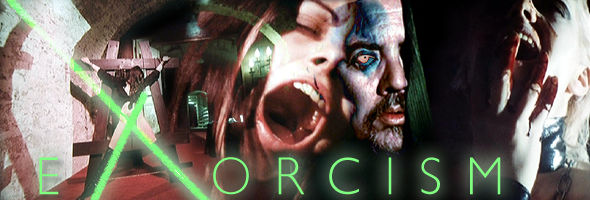
Color, 1974, 97m.
Directed by Jess Franco
Starring Jess Franco, Lina Romay, Catherine Lafferière, Nadine Pascal, Pierre Taylou, Roger Germanes, Monica Swinn
Kino Lorber (Blu-Ray & DVD) (US RA/R1 HD/NTSC), Synapse (US R0 NTSC), Dutch Filmworks (Holland R2 PAL), Arrow (UK R0 PAL), Manga (Spain R2 PAL) / WS (1.66:1) (16:9)
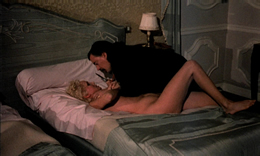 Though the title conjures up images of a dubbed Exorcist imitation replete with levitations and chanting priests, this early '70s concoction from Jess Franco is actually something far more personal and unsettling. His earlier work was certainly no stranger to combining sex and violence in abnormally high doses, but Exorcism (or as it was known in its first European incarnation, Exorcismes et messes noires) pushes the d
Though the title conjures up images of a dubbed Exorcist imitation replete with levitations and chanting priests, this early '70s concoction from Jess Franco is actually something far more personal and unsettling. His earlier work was certainly no stranger to combining sex and violence in abnormally high doses, but Exorcism (or as it was known in its first European incarnation, Exorcismes et messes noires) pushes the d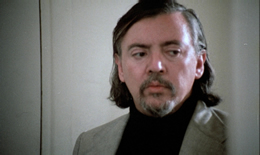 irector into more graphic territory than his earlier X-rated but comparatively tame offerings like Succubus by serving up one helping of depraved activity after another, linked by only the thinnest connective tissue of a plotline.
irector into more graphic territory than his earlier X-rated but comparatively tame offerings like Succubus by serving up one helping of depraved activity after another, linked by only the thinnest connective tissue of a plotline.
The film begins with a protracted eight-minute sequence in which a nude Lina Romay, transfixed to a wooden cross, is tortured by elegant blonde Catherine Lafferiere, who knifes a dove and smears her victim with its blood. This display turns out to be pure theatre, a decadent bit of thespian role play performed for an appreciative nightclub audience. However, so-called priest and recent mental patient Mathis Vogel (Franco) finds these displays representative of a demonic disease spreading throughout society, and he means to purge these demons at any cost. He writes stories for a local publication (where Romay happens to work as a secretary and dabbles in lesbian affairs during her off hours), but his real crusade involves the purgative deaths of corrupt souls. Meanwhile the police investigate the insidious crimes with the aid of a virile writer (The Midnight Party's Taylou) from Franco's office, leading to a final showdown over the future of Romay's soul.
Set in a dark, deadly Paris populated exclusively by selfish, deluded nutcases, Exorcism works best as a look at the dark side of the free, swinging attitudes popular at the time. Swingers clubs, orgies, and even one-on-one bedroom encounters have a tendency to hide nasty secrets; it actually makes sense that Vogel's deranged conception of himself as a sexualized angel of death could spring from this environment, but Franco clearly keeps the line drawn between fantasy and reality. Though produced as a hard mixture of simulated sex and violence, the Eurociné film was reissued with hardcore inserts (some performed by Franco himself, according to a Video Watchdog interview with company 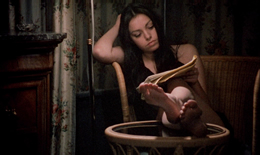 head Daniel Lesouer) which of course made the film even less erotic. The most widely-seen VHS version, Demoniac, appeared on US video from Wizard in a heavily butchered version and actually represents an alternate 1979 edition with newly filmed plot exposition and additional sequences of Franco wandering around Paris. The "uncut" version of this variant, entitled The Sadist of Notre Dame, made the rounds in Europe and turned up somewhat more completely on UK video courtesy of Redemption.
head Daniel Lesouer) which of course made the film even less erotic. The most widely-seen VHS version, Demoniac, appeared on US video from Wizard in a heavily butchered version and actually represents an alternate 1979 edition with newly filmed plot exposition and additional sequences of Franco wandering around Paris. The "uncut" version of this variant, entitled The Sadist of Notre Dame, made the rounds in Europe and turned up somewhat more completely on UK video courtesy of Redemption.
The "producer's cut" of this film from Eurociné first made its way to DVD courtesy of Synapse in what could be considered the most coherent of all possible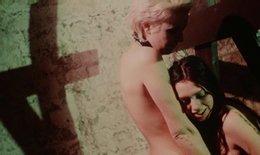 versions. Cobbling together the export Exorcismes version with some additional footage from the vaults (some of which seems to have been prepared for Sadist, judging from the dialogue about Vogel's mental history), the disc contains the hardest possible footage without resorting to the jarring XXX inserts (which also marred the hard porn release of Franco's Female Vampire). Apart from the virtually nonstop nudity, this cut also contains the full entrail-ripping murder scene in which Vogel graphically knifes open one of his victims. In short, this is essential viewing for those interested in Franco, but some newcomers may be left scratching their heads as the film veers from one extreme to another. The only unquestionable failing of the film is its dialogue track, which was apparently recorded without sound and poorly dubbed in every possible language. The English version is as sloppy and grating as it always has been, but Franco fanatics should know exactly what to expect. Some damage to the original film crops up during the opening sequence, which features some scratches and jumps throughout the credit sequence, while some of the original edits between shots were evidently done quickly on the cheap based on some noticeable shifting and jumping. The text for the credits seems to be equally careless, with inconsistent fonts (some not even properly placed on the frame) giving the false indication that something might be wrong with the film's framing. However, the anamorphic transfer itself is framed at the original European aspect ratio of 1.66:1 and the mono soundtrack (sporting a nifty, sinister organ score) sounds fine. Of course, the Synapse release really earned its place in the history books for featuring Franco's first-ever audio commentary, which is about as strange, fascinating, and erratic as one could possibly hope. His English hasn't improved much over the years, but his comments moderated by current producer Kevin Collins are generally intelligible with close listening and an understanding of the questions from the adept moderator. Occasional lapses into silence are filled in with the film's soundtrack; however, Franco finds enough to say about the actors and the filming to make the experience worthwhile. Other extras include a lengthy theatrical trailer (under the Demoniac title), an alternate four minute version of the opening scene with both women fully clothed, a stills gallery, and a nifty two-sided Amaray sleeve offering dual artwork options.
versions. Cobbling together the export Exorcismes version with some additional footage from the vaults (some of which seems to have been prepared for Sadist, judging from the dialogue about Vogel's mental history), the disc contains the hardest possible footage without resorting to the jarring XXX inserts (which also marred the hard porn release of Franco's Female Vampire). Apart from the virtually nonstop nudity, this cut also contains the full entrail-ripping murder scene in which Vogel graphically knifes open one of his victims. In short, this is essential viewing for those interested in Franco, but some newcomers may be left scratching their heads as the film veers from one extreme to another. The only unquestionable failing of the film is its dialogue track, which was apparently recorded without sound and poorly dubbed in every possible language. The English version is as sloppy and grating as it always has been, but Franco fanatics should know exactly what to expect. Some damage to the original film crops up during the opening sequence, which features some scratches and jumps throughout the credit sequence, while some of the original edits between shots were evidently done quickly on the cheap based on some noticeable shifting and jumping. The text for the credits seems to be equally careless, with inconsistent fonts (some not even properly placed on the frame) giving the false indication that something might be wrong with the film's framing. However, the anamorphic transfer itself is framed at the original European aspect ratio of 1.66:1 and the mono soundtrack (sporting a nifty, sinister organ score) sounds fine. Of course, the Synapse release really earned its place in the history books for featuring Franco's first-ever audio commentary, which is about as strange, fascinating, and erratic as one could possibly hope. His English hasn't improved much over the years, but his comments moderated by current producer Kevin Collins are generally intelligible with close listening and an understanding of the questions from the adept moderator. Occasional lapses into silence are filled in with the film's soundtrack; however, Franco finds enough to say about the actors and the filming to make the experience worthwhile. Other extras include a lengthy theatrical trailer (under the Demoniac title), an alternate four minute version of the opening scene with both women fully clothed, a stills gallery, and a nifty two-sided Amaray sleeve offering dual artwork options.
The 2012 edition from Kino Lorber and Redemption Films seems like a wise decision given the film's title and its high exploitation factor, with the producer's cut wisely chosen here as the main version of choice. The transfer itself appears to be from the same negative used for the Synapse one, though contrast is better with whites far less prone to blowing out in some scenes. Colors are fine given the intentionally grungy nature of the film itself, and the usual inherent damage (especially in the credits) is still here and accounted for. Blu-Ray consumers used to Hollywood's latest and greatest will probably furrow their brows after laying eyes on this one, but really, anyone who knows the history of this film should be pretty pleased with how it turned out. The English audio is the only option here, which is just as well since this is one case where the French dubbed version isn't really superior. As usual, the Blu-Ray includes the theatrical trailer as well as bonus ones for Female Vampire and three Jean Rollin bloodsucker titles. The significantly different, alternate Demoniac cut (with that actual title shown onscreen) is also included, clocking in at 69 minutes and featuring alternate clothed takes of several scenes with some of the additional Franco footage tossed in for good measure. It looks fine, roughly comparable to the main feature. You don't get the Jess commentary this time around, but given the upgrade in image quality and the inclusion of the other version known to trash VHS connoisseurs, this seems like an easy recommendation.
Updated review on November 8, 2012.
![]()